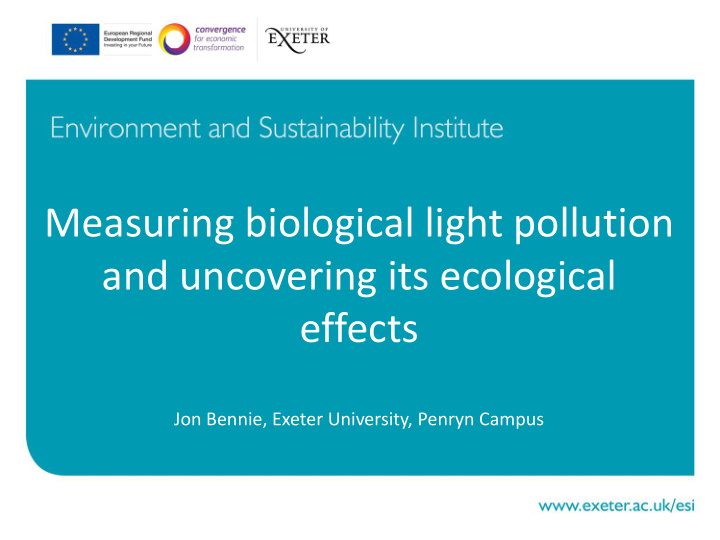



Measuring biological light pollution and uncovering its ecological effects Jon Bennie, Exeter University, Penryn Campus
Plant seasonal timing (phytochrome) on off Plant growth Daily cycle in mammals and birds (melatonin suppression) Bumblebee vision Human vision Ultra-violet Visible light Far-red
Behavior of Loggerhead Sea Turtles on an Urban Beach. II. Hatchling Orientation Photo: Kirsty Smith Salmon et al. http://creativecommons.org/licenses/by- "Common Redshank Tringa totanus" by Andreas Trepte - Own work. CC BY-SA 2.5 via sa/2.0/ Vol. 29, No. 4 (Dec., 1995), pp. 568-576 Wikimedia Commons -
Dacke et al., (2013) Dung beetles use the milky way for orientation Current Biology 23 (4) 298-300 Photo: Kirsty Smith http://creativecommons.org/licenses/by- "Common Redshank Tringa totanus" by Andreas Trepte - Own work. CC BY-SA 2.5 via sa/2.0/ Wikimedia Commons -
Small ermine moths ( Yponomeuta cagnagella ) adapt to urban areas by reducing their “flight to light” behaviour Altermatt & Ebert Reduced flight-to-light behaviour of moth populations exposed to long-term urban Photo: Kirsty Smith http://creativecommons.org/licenses/by- light pollution "Common Redshank Tringa totanus" by Andreas Trepte - Own work. CC BY-SA 2.5 via sa/2.0/ Wikimedia Commons - Biology Letters (2016), doi: 10.1098/rsbl.2016.0111
Ecological effects or artificial light • Artificial light can have profound effects on the physiology and behaviour of species • Mediated through the effects on rhythms , spectra and intensity of natural light • How does this affect populations and structure of ecological communities ? • How widespread are these effects in ecosystems?
Search for evidence for: • Species population- level effects of artificial light? • Species community- level effects of artificial light? • Regional effects of artificial light (sky-glow)? • Landscape effects of networks of artificial light? • Opportunities to minimise ecological effects. -> ECOLIGHT project
"Blackbird tree" by John Arundel - http://commons.wikimedia.org/wiki/File:Blackbird_tree.jpg#mediaviewer/File:Blackbird_tree.jpg
Photo: Kirsty Smith http://creativecommons.org/licenses/by- "Common Redshank Tringa totanus" by Andreas Trepte - Own work. CC BY-SA 2.5 via sa/2.0/ Wikimedia Commons -
Photo: Kirsty Smith http://creativecommons.org/licenses/by- "Common Redshank Tringa totanus" by Andreas Trepte - Own work. CC BY-SA 2.5 via sa/2.0/ Wikimedia Commons -
Photo: Kirsty Smith http://creativecommons.org/licenses/by- "Common Redshank Tringa totanus" by Andreas Trepte - Own work. CC BY-SA 2.5 via sa/2.0/ Wikimedia Commons -
Light measured in hedgerow beside roadway from sunset to sunrise Cloudy daylight Sunrise/sunset Living room Street lights
November 17th December 1st December 6th 30 th March
Empirical measurement of the time of budburst on trees near path lighting on Exeter University campus
Dark
Bird song occurs earlier in some birds "Blackbird tree" by John Arundel - http://commons.wikimedia.org/wiki/File:Blackbird_tree.jpg#mediaviewer/File:Blackbird_tree.jpg
Does light pollution alter daylength? A test using light loggers on free- ranging European blackbirds ( Turdus merula ) Dominoni & Partecke 2015 Phil Trans B Volume: 370 Issue: 1667 "Blackbird tree" by John Arundel - http://commons.wikimedia.org/wiki/File:Blackbird_tree.jpg#mediaviewer/File:Blackbird_tree.jpg
Blackbirds Blackbirds exposed to exposed to streetlight streetlight do mature earlier not mature in in first year second year "Blackbird tree" by John Arundel - http://commons.wikimedia.org/wiki/File:Blackbird_tree.jpg#mediaviewer/File:Blackbird_tree.jpg
20 km from city 9 km from city City Centre Natural lunar cycle
Barn owl sensitive to light "Barn Owl flying" by Kristina Servant - https://www.flickr.com/photos/xkristinax/9649002129/. Licensed under CC BY 2.0 via Wikimedia Commons - http://commons.wikimedia.org/wiki/File:Barn_Owl_flying.jpg#mediaviewer/File:Barn_Owl_flying.jpg
Redshank have two modes of feeding. Birds attracted to oil refinery use daytime mode (eyesight) which is more efficient than nocturnal mode of feeding by probing Photo: Kirsty Smith http://creativecommons.org/licenses/by- "Common Redshank Tringa totanus" by Andreas Trepte - Own work. CC BY-SA 2.5 via sa/2.0/ Wikimedia Commons -
Larger bats avoid lit areas "Blackbird tree" by John Arundel - http://commons.wikimedia.org/wiki/File:Blackbird_tree.jpg#mediaviewer/File:Blackbird_tree.jpg
http://www.batconservationireland.org/ Changes in Irish bat population and diversity with time "Blackbird tree" by John Arundel - http://commons.wikimedia.org/wiki/File:Blackbird_tree.jpg#mediaviewer/File:Blackbird_tree.jpg
3D high resolution light modelling How do organisms respond to: • fine-scale patchiness of light • variation in spectral composition • temporal changes http://www.batconservationireland.org/ "Blackbird tree" by John Arundel - http://commons.wikimedia.org/wiki/File:Blackbird_tree.jpg#mediaviewer/File:Blackbird_tree.jpg
Potential landscape-scale effects of direct light in restricting movement
"Blackbird tree" by John Arundel - http://commons.wikimedia.org/wiki/File:Blackbird_tree.jpg#mediaviewer/File:Blackbird_tree.jpg
Innovative mapping of bat transit routes using electrical resistance analogy Bennie J , Davies TW, Inger R, Gaston KJ (2014) Mapping artificial Bennie J , Davies TW, Inger R, Gaston KJ (2014) Mapping artificial lightscapes for ecological studies. Methods in Ecology and Evolution lightscapes for ecological studies. Methods in Ecology and Evolution 5 6 534-540 5 6 534-540
Modelling movement paths "Blackbird tree" by John Arundel - http://commons.wikimedia.org/wiki/File:Blackbird_tree.jpg#mediaviewer/File:Blackbird_tree.jpg
Modelling movement paths "Blackbird tree" by John Arundel - http://commons.wikimedia.org/wiki/File:Blackbird_tree.jpg#mediaviewer/File:Blackbird_tree.jpg
"Blackbird tree" by John Arundel - http://commons.wikimedia.org/wiki/File:Blackbird_tree.jpg#mediaviewer/File:Blackbird_tree.jpg
Community and population-level effects – potential for light at night to locally restructure communities
Exeter field experiment "Blackbird tree" by John Arundel - http://commons.wikimedia.org/wiki/File:Blackbird_tree.jpg#mediaviewer/File:Blackbird_tree.jpg
Exeter field experiment site "Blackbird tree" by John Arundel - http://commons.wikimedia.org/wiki/File:Blackbird_tree.jpg#mediaviewer/File:Blackbird_tree.jpg
Mesocosm experiment "Blackbird tree" by John Arundel - http://commons.wikimedia.org/wiki/File:Blackbird_tree.jpg#mediaviewer/File:Blackbird_tree.jpg
"Blackbird tree" by John Arundel - http://commons.wikimedia.org/wiki/File:Blackbird_tree.jpg#mediaviewer/File:Blackbird_tree.jpg
"Blackbird tree" by John Arundel - http://commons.wikimedia.org/wiki/File:Blackbird_tree.jpg#mediaviewer/File:Blackbird_tree.jpg
"Blackbird tree" by John Arundel - http://commons.wikimedia.org/wiki/File:Blackbird_tree.jpg#mediaviewer/File:Blackbird_tree.jpg
Effects of artificial light on wildlife Light as information: • Interferes with detection of seasonal changes in daylength (tree budburst and leaf-fall; flowering in plants; breeding in birds) • Alters detection of day and night (melatonin production in mammals and birds) • Obscures natural cues for navigation (seabirds, night- flying insects)
Effects of artificial light on wildlife Light as a resource: • Increased activity of diurnal species (eg. songbirds) and some predators and foragers (owls, spiders, waders, pipistrelles around streetlamps) • Reduced activity of light-shy species (eg. lesser horseshoe bat, rodents) Light as a barrier: • Fragments landscapes by repelling or trapping animals (eg.bats, moths)
Effects of artificial light on wildlife Ecosystem effects: • Effects of artificial light on seasonal timing may lead to mismatches between species • Light may disrupt predator-prey interactions (top-down effects) • Light may alter the availability of food resources (bottom-up effects) • Light may alter other interactions between species (eg. nocturnal pollination)
Effects of artificial light on wildlife Ecosystem effects: • Artifical light may have unexpected consequences • Acting together with other pressures – climate change, land-use changes, habitat loss
Thanks for listening. Contact us: j.j.bennie@exeter.ac.uk k.j.gaston@exeter.ac.uk
Recommend
More recommend